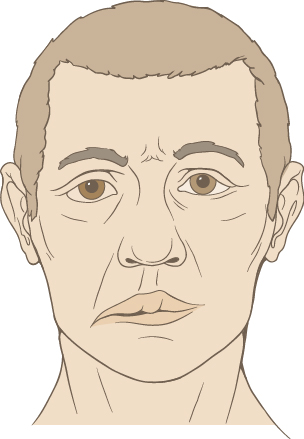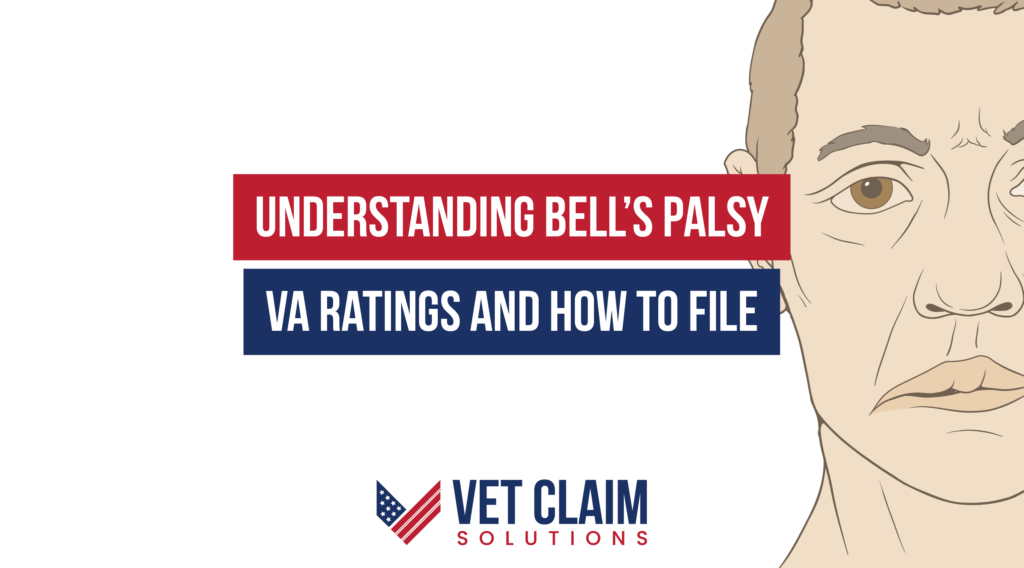Bell’s palsy, a condition that causes sudden facial weakness, can significantly impact your life. It can make even simple tasks challenging, especially if it lingers or recurs. But did you know that if Bell’s palsy is connected to your military service, you might be eligible for benefits through the VA disability system? This post will unpack what you need to know about Bell’s Palsy VA ratings to understand how the VA system handles this condition, the potential rating percentages you may receive, and what you need to file a successful claim.
Bell’s Palsy VA ratings are decided by looking at the severity of your symptoms and how they impact your ability to work and function in everyday life. Because the symptoms can vary from mild weakness to total facial paralysis, ratings aren’t one-size-fits-all. I’ll cover what makes a Bell’s Palsy claim “service-connected”, including primary and secondary service connections. We’ll then cover how the VA assigns different disability rating percentages.
Understanding Bell’s Palsy

Before diving into VA disability ratings, let’s ensure we understand Bell’s Palsy. This condition occurs when the seventh cranial nerve, also called the facial nerve, becomes inflamed or swollen.
While the exact causes are unclear, viral infections like the flu or herpes simplex are often suspected culprits. Bell’s palsy generally leads to facial droop or weakness on one side of the face, making it tough to close your eyes, smile, or make normal facial expressions. Think about the everyday things we take for granted– eating, talking, even blinking– suddenly become much more difficult.
Other symptoms may include drooling, dry eyes or mouth, changes in taste, and even pain in or around the ear. Most folks start feeling better within a few weeks, with complete recovery in a few months. Although many people fully recover, some experience long-term effects like residual weakness or recurring Bell’s palsy. In some instances, permanent nerve damage or recurring symptoms are a real possibility.
Service Connection for Bell’s Palsy VA Ratings
The Department of Veterans Affairs offers disability compensation for Bell’s palsy, but the key is proving a service connection. Essentially, this means you need to show the VA that your condition was caused or aggravated by your military service.
Direct Service Connection
For a direct service connection, the VA requires evidence of three things:
- A current Bell’s palsy diagnosis: You must have a clear diagnosis from a medical professional.
- In-service event, injury, or illness: Something must have happened during your military service that you believe led to or contributed to your Bell’s palsy. Maybe it was an ear infection, facial trauma, or exposure to harsh conditions. Any documented medical event that might have contributed is helpful.
- Medical nexus: This is a vital piece of the puzzle. A medical professional needs to review your records and make the connection – offering an opinion that your in-service incident “at least as likely as not” caused or aggravated your Bell’s palsy.
Don’t feel overwhelmed. You don’t have to do this alone. When preparing to file your claim, it’s smart to gather any medical records from your time in service, as well as documents from after your discharge. The more evidence you have, the better your chances. To officially file for benefits, complete VA Form 21-526EZ. You can submit it online, via mail, or in-person at your nearest VA regional office.

Secondary Service Connection
There’s another way to qualify for Bell’s Palsy VA ratings. This involves a secondary service connection. Sometimes Bell’s palsy is a consequence of another service-connected condition. Think of it like this– imagine you suffered a head injury in service that later led to recurring episodes of Bell’s palsy. Here’s what you would need:
- Diagnosis of secondary Bell’s palsy: Get a clear diagnosis from a doctor.
- Nexus evidence: Just like with a direct service connection, a medical professional must link your service-connected disability and Bell’s palsy, concluding that it was at least as likely as not caused or aggravated by the primary condition.
For example, suppose you’re service-connected for high blood pressure. Later, you develop Bell’s palsy. A medical professional’s opinion linking these two conditions could fulfill that important nexus requirement for a secondary service connection.
How Does the VA Assign Bell’s Palsy VA Ratings?
Once a service connection is established– either directly or secondary to another condition – the VA then determines your Bell’s Palsy VA disability rating. These ratings decide how much compensation you’ll receive each month. As explained in 38 CFR § 4.124a, Bell’s palsy ratings fall under diagnostic code 8207 for paralysis of the facial nerve. Your rating will depend on how much facial paralysis you experience due to Bell’s palsy.
The ratings go in steps from mild to severe:
| VA Rating | Level of Paralysis |
|---|---|
| 10% Rating | Incomplete, moderate paralysis |
| 20% Rating | Incomplete, severe paralysis |
| 30% Rating | Complete paralysis |
VA raters also consider the “relative loss of innervation of facial muscles” when deciding on a specific rating. This essentially means they assess how well the muscles in your face are still receiving signals from your nerves. Seeking a free case evaluation from a veterans law firm can help you gather the necessary documentation and evidence for a successful claim. They can also connect you with experienced medical professionals who can provide expert opinions and testimony.
C&P Exams: What to Expect

To evaluate the severity of your Bell’s palsy, the VA will often schedule a Compensation and Pension (C&P) exam. This is a key part of the claims process, so it pays to know what to expect. A VA examiner will likely ask you about your symptoms, their severity, how often they occur, and the overall impact they have on your life. Be open and honest with them, and let them know about any work limitations you face because of your Bell’s palsy.
It is their job to assess the severity of your condition so do not be afraid to be detailed when speaking to them. Understanding the VA disability calculator and how it works can help veterans understand their potential benefits and plan accordingly.
FAQs about Bell’s Palsy VA Ratings
1. Can I get disability for Bell’s palsy?
Yes, veterans may qualify for VA disability benefits if they can prove their Bell’s palsy is service-connected. Service connection involves showing your Bell’s palsy was caused by or aggravated by something that happened during your military service.
2. Can you claim Bell’s palsy?
Absolutely. You can claim Bell’s palsy for VA disability benefits. Submit your claim along with evidence demonstrating a connection between your condition and military service, either through a direct or secondary service connection. Medical records, service records, and witness testimony can all support your case.
3. What category is Bell’s palsy?
VA rates Bell’s palsy under diagnostic code 8207, which falls under neurological conditions. You’ll receive a rating of 10%, 20%, or 30% based on the severity of facial paralysis and its impact on your daily life.
4.Can PTSD cause Bell’s palsy?
The exact causes of Bell’s palsy are complex and often unclear. However, conditions that impact your immune system or overall health can be a contributing factor. Though research is ongoing, there are currently no studies definitively proving a direct causal relationship between PTSD and Bell’s palsy.
If you believe PTSD played a role in developing your condition, working with a knowledgeable medical professional to establish a link will be important when pursuing a secondary service connection for Bell’s palsy. If you are struggling with the effects of Bell’s palsy and are a veteran, it is important to understand your rights and seek the support you deserve. Resources such as the VA disability appeal process and experienced veterans law attorneys are available to assist you.
5. What is the VA rating for nerve paralysis?
Nerve paralysis ratings depend on the specific nerve affected and its function. Since Bell’s palsy impacts the 7th cranial nerve (facial nerve), its ratings fall under diagnostic code 8207. To give you a general idea, this specific rating can range from 10% for incomplete, moderate paralysis up to 30% for complete facial paralysis. For more precise details, consult the VA Schedule for Rating Disabilities which outlines the criteria for various nerve paralysis conditions.
6. Is Bell’s palsy a big deal?
Though often temporary, Bell’s palsy can be a significant concern. It can cause difficulties with eating, drinking, speaking, blinking, and overall facial movement, potentially impacting both your work and personal life. Some individuals experience residual weakness, chronic pain, or even recurrent episodes, making the long-term effects more severe. It’s essential to treat any episode promptly and get support for managing any ongoing effects that may negatively affect your quality of life.
If you have been diagnosed with Bell’s Palsy and believe it is related to your military service, it’s important to document your symptoms, seek medical attention, and gather all relevant medical records. These records will be crucial in establishing a service connection and supporting your VA disability claim. Additionally, it can be helpful to connect with other veterans who have experienced similar conditions and seek guidance from veterans’ organizations or support groups. Remember, you are not alone, and there are resources available to assist you in obtaining the benefits and support you deserve.
Conclusion
Navigating Bell’s Palsy VA ratings can seem complicated. If you think you may be eligible for VA benefits, gathering thorough documentation is a key starting point. I recommend talking with a knowledgeable medical professional about how to best build a successful claim for benefits based on your unique situation. Remember, even if the process seems daunting, many resources and support networks are available to veterans, helping you through each step.


